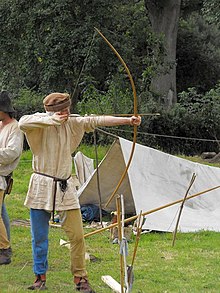
Back طاقة وضع Arabic স্থিতি শক্তি Assamese Enerxía potencial AST Potensial enerji Azerbaijani Enerhiyang potensyal BCL Патэнцыяльная энергія Byelorussian Патэнцыйная энэргія BE-X-OLD Потенциална енергия Bulgarian বিভব শক্তি Bengali/Bangla Potencijalna energija BS
| Potential energy | |
|---|---|
 In the case of a bow and arrow, when the archer does work on the bow, drawing the string back, some of the chemical energy of the archer's body is transformed into elastic potential energy in the bent limb of the bow. When the string is released, the force between the string and the arrow does work on the arrow. The potential energy in the bow limbs is transformed into the kinetic energy of the arrow as it takes flight. | |
Common symbols | PE, U, or V |
| SI unit | joule (J) |
Derivations from other quantities | U = m ⋅ g ⋅ h (gravitational) U = 1⁄2 ⋅ k ⋅ x2 (elastic) |
| Part of a series on |
| Classical mechanics |
|---|
In physics, potential energy is the energy held by an object because of its position relative to other objects, stresses within itself, its electric charge, or other factors.[1][2] The term potential energy was introduced by the 19th-century Scottish engineer and physicist William Rankine,[3][4][5] although it has links to the ancient Greek philosopher Aristotle's concept of potentiality.
Common types of potential energy include the gravitational potential energy of an object, the elastic potential energy of a deformed spring, and the electric potential energy of an electric charge in an electric field. The unit for energy in the International System of Units (SI) is the joule (symbol J).
Potential energy is associated with forces that act on a body in a way that the total work done by these forces on the body depends only on the initial and final positions of the body in space. These forces, whose total work is path independent, are called conservative forces. If the force acting on a body varies over space, then one has a force field; such a field is described by vectors at every point in space, which is in-turn called a vector field. A conservative vector field can be simply expressed as the gradient of a certain scalar function, called a scalar potential. The potential energy is related to, and can be obtained from, this potential function.
- ^ Jain, Mahesh C. (2009). "Fundamental forces and laws: a brief review". Textbook of Engineering Physics, Part 1. PHI Learning Pvt. Ltd. p. 10. ISBN 978-81-203-3862-3.
- ^ McCall, Robert P. (2010). "Energy, Work and Metabolism". Physics of the Human Body. JHU Press. p. 74. ISBN 978-0-8018-9455-8.
- ^ Cite error: The named reference
Rankin1853was invoked but never defined (see the help page). - ^ Cite error: The named reference
Roche2003was invoked but never defined (see the help page). - ^ Cite error: The named reference
SmithEnergywas invoked but never defined (see the help page).

